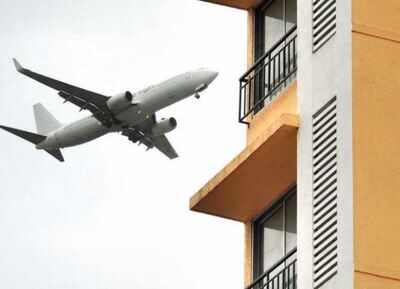
MUMBAI: Ravindra More had learnt to dismiss the constant noise from planes flying over his Vakola home as “fate”. The deafening sound occurred 24/7 every three or four minutes and visitors used to stuff cotton wool in their ears. But the past 55 days have been a lifetransforming experience with only a few flights arriving or taking off from the Mumbai airport. “I’ve never slept better,” confides More.
Those staying close to the tracks are also reporting a marked difference in their daily lives. “I don’t have to yell to be heard over the din of passing trains,” said Dahisar-based homemaker Neela Joshi whose kitchen window overlooks railway tracks.
The experiences of More and Joshi underline anti-noise crusader Sumaira Abdulali’s point. “People think they become immune to noise, but that’s far from the truth,” she says.
The British Medical Journal has documented findings of a study conducted in 2013. Researchers at Imperial College London and King’s College London compared data on day-and night-time aircraft noise with hospital admissions and mortality rates among a population of 3.6 million people living near Heathrow Airport. The risks were around 10-20% higher in areas with highest levels of aircraft noise compared to areas with least noise.
Last year, residents of Vile Parle’s Kailash Cottage Society got decibel meters to measure the noise during arrival and landing of flights at the airport located less than half a kilometre away. “It was more than 80 dB. Organisers of rallies at Shivaji Park have been booked for noise levels exceeding 65dB. But we had been living this nightmare every day,” said Parag Sharma, a resident.
Now, residents in the Vile Parle-Santacruz-Kurla belt are enjoying the flip side of the lockdown. “My pet dogs no longer whimper or run for cover and my infant sleeps uninterrupted for hours,” said Tara Deshmukh, an interior decorator in Vile Parle.
In parts of Europe and Australia, no scheduled flying takes place at night, except during emergencies. India has no such rules. “If an aircraft puts its gears down early, there is a lot of noise,” said Captain Amit Singh, fellow with the Royal Aeronautical Society, London. “There are heavy fines levied abroad if the airline does not meet certain noise requirements. In India, the problem is enforcement,” he adds. “Delhi has multiple runways and they have the option of using a runway which avoids overflight of densely populated areas close to the airport, but Mumbai doesn’t have that flexibility,” said Singh.
Post lockdown, serious thought should be given to reduce noise, say experts. “The noise levels residents along the tracks are subjected to have never been addressed. Tracks have quadrupled, but no thought has been given to installing rail dampers,” said Manish Mishra whose home kisses the tracks at Santacruz.
“Sound barriers can be installed adjacent to tracks, just like it is done on flyovers,” said Abdulali. “Similarly, if airports can go silent, why can’t the outside areas of airports get some respite from noise? With new airports, like the one coming up at Navi Mumbai, government can plan green spaces so that residences don’t come up along flight take off path,” she added.
Those staying close to the tracks are also reporting a marked difference in their daily lives. “I don’t have to yell to be heard over the din of passing trains,” said Dahisar-based homemaker Neela Joshi whose kitchen window overlooks railway tracks.
The experiences of More and Joshi underline anti-noise crusader Sumaira Abdulali’s point. “People think they become immune to noise, but that’s far from the truth,” she says.
The British Medical Journal has documented findings of a study conducted in 2013. Researchers at Imperial College London and King’s College London compared data on day-and night-time aircraft noise with hospital admissions and mortality rates among a population of 3.6 million people living near Heathrow Airport. The risks were around 10-20% higher in areas with highest levels of aircraft noise compared to areas with least noise.
Last year, residents of Vile Parle’s Kailash Cottage Society got decibel meters to measure the noise during arrival and landing of flights at the airport located less than half a kilometre away. “It was more than 80 dB. Organisers of rallies at Shivaji Park have been booked for noise levels exceeding 65dB. But we had been living this nightmare every day,” said Parag Sharma, a resident.
Now, residents in the Vile Parle-Santacruz-Kurla belt are enjoying the flip side of the lockdown. “My pet dogs no longer whimper or run for cover and my infant sleeps uninterrupted for hours,” said Tara Deshmukh, an interior decorator in Vile Parle.
In parts of Europe and Australia, no scheduled flying takes place at night, except during emergencies. India has no such rules. “If an aircraft puts its gears down early, there is a lot of noise,” said Captain Amit Singh, fellow with the Royal Aeronautical Society, London. “There are heavy fines levied abroad if the airline does not meet certain noise requirements. In India, the problem is enforcement,” he adds. “Delhi has multiple runways and they have the option of using a runway which avoids overflight of densely populated areas close to the airport, but Mumbai doesn’t have that flexibility,” said Singh.
Post lockdown, serious thought should be given to reduce noise, say experts. “The noise levels residents along the tracks are subjected to have never been addressed. Tracks have quadrupled, but no thought has been given to installing rail dampers,” said Manish Mishra whose home kisses the tracks at Santacruz.
“Sound barriers can be installed adjacent to tracks, just like it is done on flyovers,” said Abdulali. “Similarly, if airports can go silent, why can’t the outside areas of airports get some respite from noise? With new airports, like the one coming up at Navi Mumbai, government can plan green spaces so that residences don’t come up along flight take off path,” she added.

Coronavirus outbreak
Trending Topics
LATEST VIDEOS
City
 Shocking: TikTok star Faizal Siddiqui in trouble after his video ‘glorifying’ acid attack on women
Shocking: TikTok star Faizal Siddiqui in trouble after his video ‘glorifying’ acid attack on women  Madurai: Father, grandmom kill female baby with cactus milk, held
Madurai: Father, grandmom kill female baby with cactus milk, held  Bus ferrying migrants to Bihar collides with truck in UP’s Kushinagar, 12 injured
Bus ferrying migrants to Bihar collides with truck in UP’s Kushinagar, 12 injured  Lockdown 4: No word of clarity from Board of Control for Cricket in India on IPL
Lockdown 4: No word of clarity from Board of Control for Cricket in India on IPL
More from TOI
Navbharat Times
Featured Today in Travel
Get the app





